 |
You are here: Home > Projects & Downloads > BVE Help and Information (Page 3)

|
Rail Sim Routes UK - BVE Help and Information (Page 3)
 |
|

BVE Help and Information |
|

|

BVE Help and Information |
Information and help for installing Mackoy's BVE Trainsim, with instructions for installing routes from this site, and setting common options within BVE.
 Revised 19th April 2009 (instructions updated for installation using the 7-Zip archive manager). [If you require assistance with using the older BVE v2.6.3, please click here] Revised 19th April 2009 (instructions updated for installation using the 7-Zip archive manager). [If you require assistance with using the older BVE v2.6.3, please click here]

|


|
Graphics Card Display Quality |
|
|
|
Introduction

This part of the BVE Help Guide explains how to enable two features found with modern 3D graphics cards which increase the quality of the visuals you see in 3D games, namely 'Anti-aliasing' and 'Anisotropic Filtering'.
The guide assumes that you are using a graphics card in either the nVIDIA GeForce or ATi Radeon product ranges, both of which include popular 3D hardware accelerators generally designed for more serious gaming performance on the PC. If you are using another type of graphics card, please consult your user guide or instruction manual for details on how to adjust it's equivalent display driver properties - not all graphics cards and drivers will enable you to alter such advanced settings however.
|
|
|
Anti-aliasing and Anisotropic Filtering

Anti-aliasing is a technique for smoothing out the jagged edges of lines or hard edges in a 3D view, often referred to as 'jaggies', and most noticeable in lower display resolutions. In BVE, enabling anti-aliasing means that such details as overhead wires or the edges of buildings are rendered in a smooth way, without any unsightly stepping effects or jagged edges to be seen.
Anisotropic filtering is a technique for reducing or removing the shimmering and 'swimming pixel' effects on textures visible in the distance, when viewed from a low angle - for example distant terrain or track textures as they get further away. In BVE, enabling anisotropic filtering significantly enhances the appearance of the graphics, especially because BVE itself doesn't support mip-mapped textures which is another technique which can reduce the effects of shimmering pixels in distant textures.
 |
Important Note: While both Anti-aliasing and Anisotropic Filtering significantly enhance the look of BVE's 3D views, they have an impact on performance as well. If you have a recent 3D hardware accelerator then such hardware is capable of using anti-aliasing and anisotropic filtering with less impact on performance. If you have an older 3D graphics card which supports anti-aliasing and anisotropic filtering, you may find framerates decrease unacceptably with high levels of anti-aliasing or anisotropy - do experiment to see what results you can get from your hardware. |
|
|

|
Graphics Card Configuration |
|
|
|
Enabling Anti-aliasing and Anisotropic Filtering in the nVIDIA ForceWare Drivers

If you use an nVIDIA GeForce graphics card, then you're probably using the ForceWare drivers which are nVIDIA's driver set for all cards in the GeForce range.
Note: One thing you should check is whether you are using nVIDIA's drivers, or the default drivers included with Windows XP - the default drivers do not allow you to adjust advanced graphics card properties like anti-aliasing or anisotropic filtering, and may also reduce your framerates and performance. If upon following these instructions, you can't find a way to display the nVIDIA Control Panel, you should download and install the latest ForceWare drivers from the nVIDIA website if you want to use the advanced driver features explained on this page.
Important: Don't install new drivers on your system unless are sure you know what you are doing. Please ensure that you can undo any changes you make to your graphics card drivers before installing new drivers - see the Windows XP Help and Support Centre for details about the 'System Restore' feature, which can roll back to the previously installed display driver should any problems occur.
This guide assumes that you're using the nVIDIA ForeWare 93.71 drivers, as these, in my experience, are the best choice for BVE 4.
Setting the Anti-aliasing and Anisotropic Filtering levels
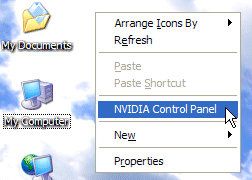 |
|
< |
First, right-click your desktop and select NVIDIA Control Panel - the following window will appear... |
|
Select the Advanced view:
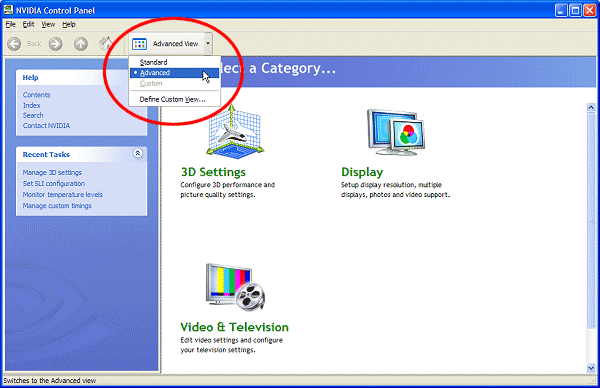
Now, click the '3D Settings' icon:
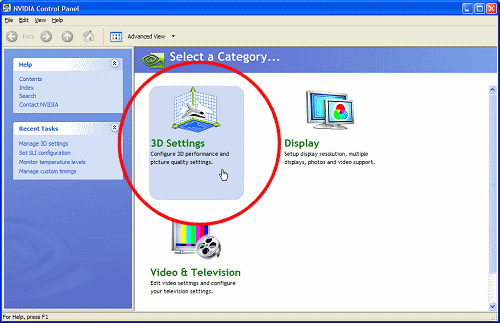
Now, click the 'Manage 3D Settings' link:
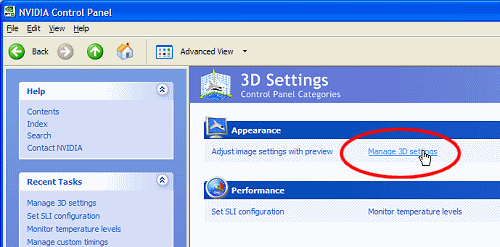
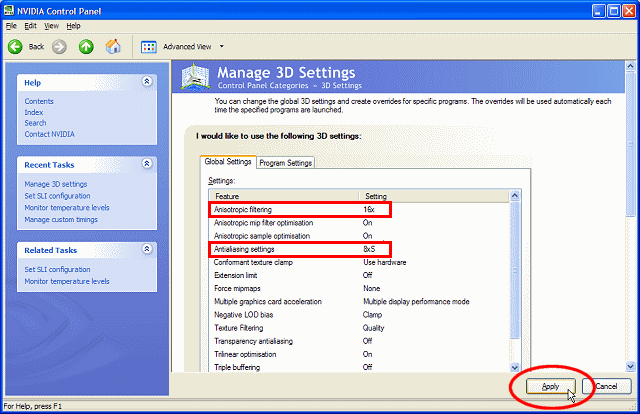
|
/\ |
In the 'Global Settings' tab, click 'Anisotropic Filtering', and then select '16x'. Next, click 'Antialiasing settings', and then select '8xS'. Now, click the 'Apply' button.
|

The anti-aliasing and anisotropic filtering levels are now set, and you can start BVE and see if the quality of your graphics has improved! If there is any performance hit and you find it unacceptable, repeat the above steps and select lower levels of anti-aliasing and anisotropic filtering, and then try BVE again.
|
|

|
Graphics Card Configuration |
|
|
|
Enabling Anti-aliasing and Anisotropic Filtering in the ATi Catalyst Drivers

If you use an ATi Radeon graphics card, then you're probably using the Catalyst drivers which are ATi's driver set for all cards in the Radeon range. This part of the guide explains changing the settings using the Catalyst Control Centre software.
Note: One thing you should check is whether you are using ATi's drivers, or the default drivers included with Windows XP - the default drivers do not allow you to adjust advanced graphics card properties like anti-aliasing or anisotropic filtering, and may also reduce your framerates and performance. If upon following these instructions, you can't find a way to display the Catalyst Control Centre, you should download and install the latest Catalyst drivers from the AMD/ATi website if you want to use the advanced driver features explained on this page.
Important: Don't install new drivers on your system unless are sure you know what you are doing. Please ensure that you can undo any changes you make to your graphics card drivers before installing new drivers - see the Windows XP Help and Support Centre for details about the 'System Restore' feature, which can roll back to the previously installed display driver should any problems occur.
Setting the Anti-aliasing and Anisotropic Filtering levels using the Catalyst Control Centre
 |
|
< |
First, right-click your desktop and select 'CATALYST(TM) Control Centre' - the Catalyst Control Centre will appear... |
|
 |
|
< |
If you are presented with this 'Basic' dialog, click the 'Advanced ...' button in the bottom left of the Catalyst Control Centre window... |
|
 |
|
< |
Provided the Advanced View is selected, a tree list containing options appears on the left - navigate to '3D' > 'All Settings'.
Now, under 'SMOOTHVISION HD:Anti-Aliasing', un-tick the 'Use application settings' checkbox, and drag the 'Level' slider to one of the available multipliers (personally I use 8x anti-aliasing). The more powerful your Radeon graphics card, the higher this setting can be without the performance penalty being too great - you may wish to experiment with the settings once you've seen how your games run with the selected level of anti-aliasing.
Now, under 'SMOOTHVISION HD:Anisotropic Filtering', again un-tick the 'Use application settings' checkbox, and drag the 'Per-pixel samples:' slider to one of the available multipliers (personally, I set it to 16x anisotropic filtering). The more powerful your Radeon graphics card, the higher this setting can be without the performance penalty being too great - again, you may wish to experiment with the settings once you've seen how your games run with the selected level of anisotropy.
Now click the 'OK' button. |
|
|
|

|
Other Useful Resources |
|
|
|
Useful websites and sources of information by other members of the BVE community

You can find an alternative guide to downloading and installing BVE over at Steve Green's Train Sim Central website. Steve's guide also includes useful information about error messages you might see whilst using BVE.
|
|
|
|
Site viewing information: This site is XHTML 1.0 compliant, and should display correctly in any recent browser with HTML 4.01 and CSS support, e.g. Firefox, Internet Explorer 6 and above, or Safari. |
|
Content last updated: 19th April 2009 |
|
 |



